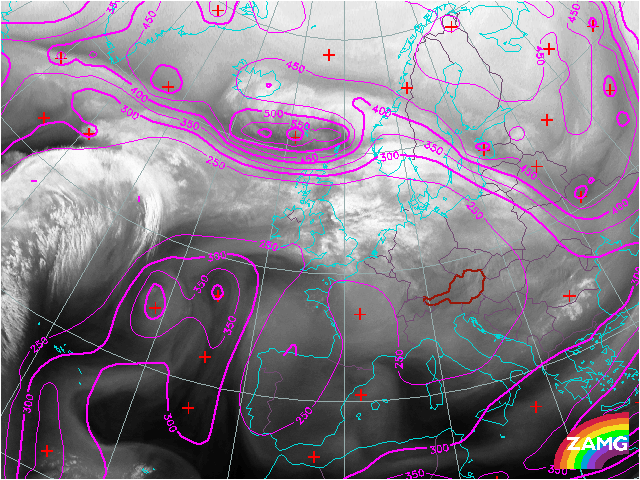

A PV maximum on the backside of the low pressure system over Scandinavia can be seen. The polar front is indicated by a strong gradient of the isolines.
The maximum of PV=1 does not deepen further. The formation of the double structure south of Greenalnd in the WV image starts.
The double strucuture of low water vapour in the upper atmosphere correlates well with the position of the polar front. The isolines of PV=1 extend remarkably far to the West in this area, which hints at descending dry stratospheric air.
The area of the forming wave structure is superimposed by a trough of PV=1.
A maximum of PV=1 is situated northwest of the wave. The isolines indicate that relative high potential vorticity accompanies the evolution of this wave.
The trough of potential vorticity moves to the South while sharpening. It correlates well with the area of cloud dissolution between the cloud head and the cold front.
The PV trough extends to the Alps now. It explains the broad area of cloud dissolution. The development of the rapid cyclogenesis is connected to the dry slot to the north of this area which develops in the next image.
A broad PV anomaly can be seen in the backside of the dry slot which is situated to the north of the area of dissolving clouds. This dry slot can be clearly seen at this time step. PV=1 reaches down to 500 hPa in this area which indicates a lowering of the tropopause, which hints at a cyclogenetic process. The model does not give a good fit to the dry slot at this time step. However, the trough which extends to the South of the Alps corresponds well with the area of cloud dissolution and indicates that a second process is going on.
At this time step the PV Anomaly correlates much better with the dry slot than six hours before. Two maxima can be recognized. One to the north is clearly associated with the dry slot and the area of rapid cyclogenesis to the north of the Alps. The isolines farther to the south hint at a second decoupled development in the entire process.
The maximum of PV=1 still coincides very well with the area of the dry slot. Upper dry stratospheric air leads to dissolution of cloudiness in the cloud head as well as at the backside of the cold front.
The model fields show a large area of PV=1 still coinciding very well with the area of cloud dissolution.